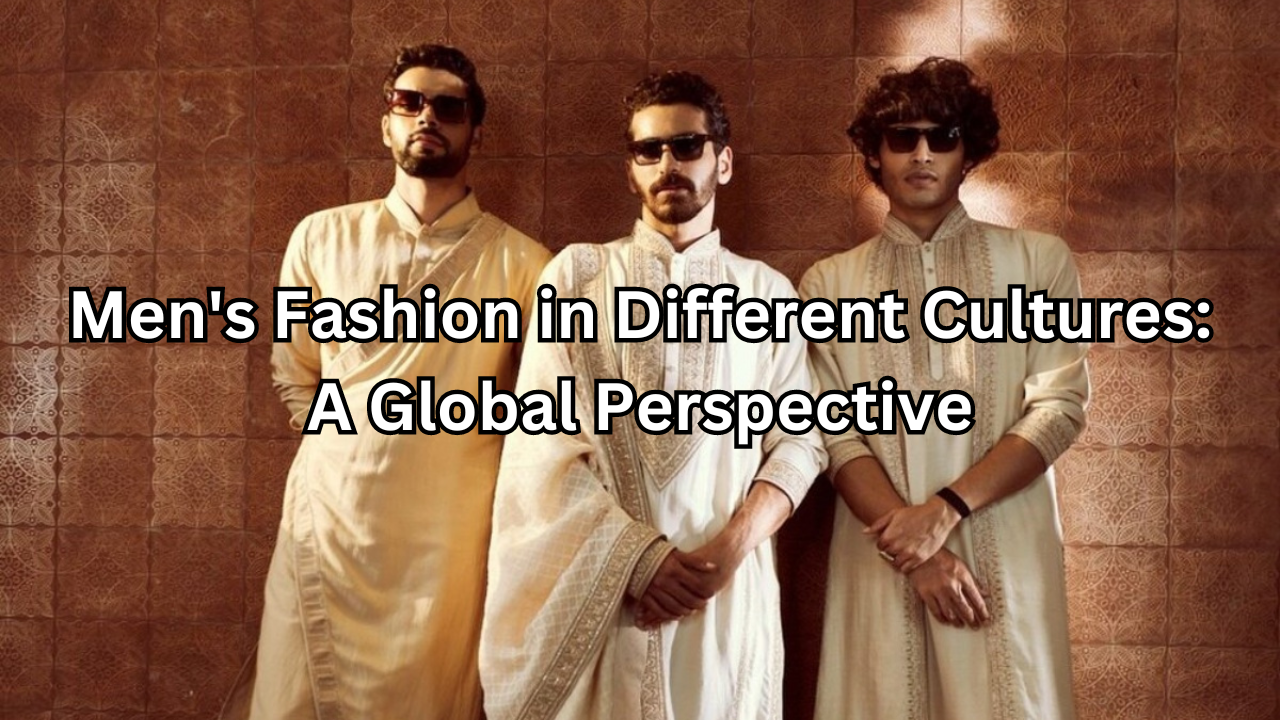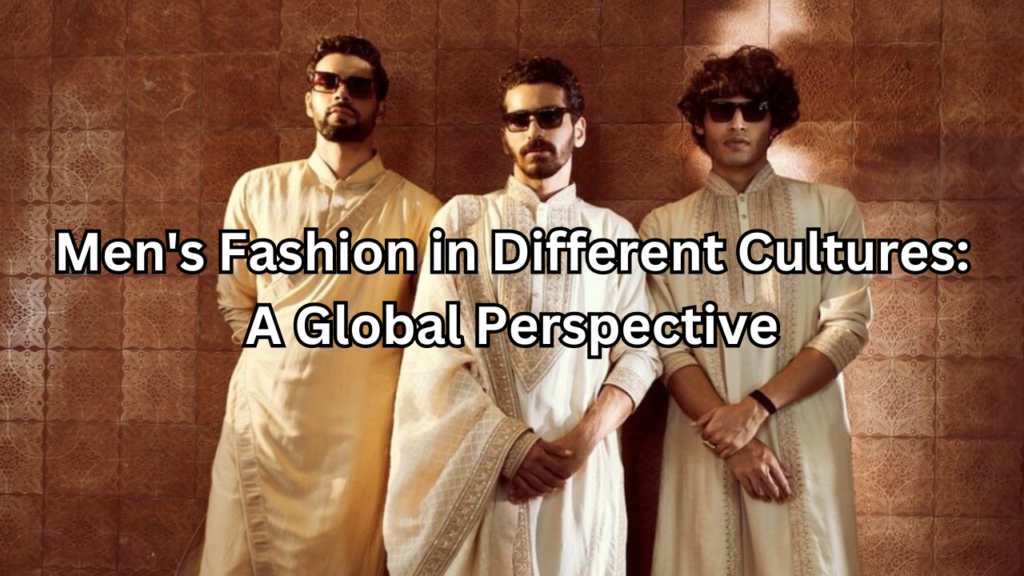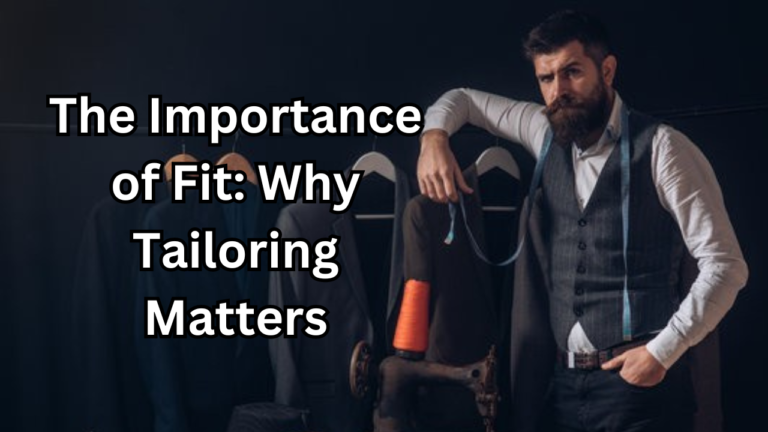

Table of Contents
Introduction:
Men’s fashion is a fascinating lens through which we can explore the diversity and richness of cultures around the world. From traditional attire passed down through generations to contemporary urban styles influenced by global trends, men’s fashion reflects a unique blend of history, values, climate, and social norms. This global perspective on men’s fashion not only highlights the creativity and innovation within different societies but also underscores the interconnectedness of our modern world. Let’s delve into the tapestry of men’s fashion across various cultures to gain a deeper understanding and appreciation for the sartorial expressions that shape our identities.
Definition of Men’s Fashion in Different Cultures:
Men’s fashion refers to the clothing, accessories, grooming styles, and overall appearance adopted by men to express their personal identity, Men’s Fashion in Different Cultures: affiliations, and social status. It encompasses a wide range of garments, from traditional attire rooted in heritage and customs to modern trends influenced by global fashion movements.
Importance of Cultural Perspective in Fashion:
The cultural perspective in Men’s Fashion in Different Cultures as it reflects the unique traditions, values, and aesthetics of a society. Fashion is not just about clothing; it is a form of cultural expression that communicates history, beliefs, and societal norms. By understanding the cultural context of fashion, we gain insights into the historical evolution of styles, the symbolism behind certain garments, and the significance of attire in rituals and ceremonies. Moreover, embracing diverse cultural perspectives in fashion promotes inclusivity, celebrates cultural heritage, and fosters creativity by encouraging the fusion of different influences.
Overview of Global Variations in Men’s Fashion:
Men’s fashion varies significantly across different regions and cultures, showcasing a rich tapestry of styles, materials, and techniques. From the tailored suits of Western business attire to the vibrant traditional clothing of African tribes, each culture contributes unique elements to the global fashion landscape. Asian countries like Japan and South Korea are known for their innovative streetwear and meticulous attention to detail, while Middle Eastern fashion often blends luxurious fabrics with traditional garments like thobes and kaftans. In Latin America, colorful and expressive cloth reflects the region’s lively culture, while Indigenous cultures worldwide preserve their heritage through intricately crafted attire and accessories.
Overall, the global variations in men’s fashion highlight the diversity and creativity inherent in human expression, illustrating how clothing serves as a powerful medium for cultural identity and artistic innovation.
Western Fashion
Western fashion encompasses a wide array of styles and trends that have evolved over centuries, influenced by historical, social, and cultural factors. It is characterized by a blend of traditional attire, modern innovations, and global influences, reflecting the dynamic nature of Western societies.
- United States:
- Business Attire: The United States is known for its professional and polished business attire, with tailored suits, dress shirts, ties, and leather shoes being common staples in corporate settings.
- Casual Wear: Men Casual wear in the U.S. often includes jeans, t-shirts, hoodies, and sneakers, emphasizing comfort and versatility.
- Europe:
- United Kingdom: Traditional British fashion is renowned for its elegance and sophistication, with tailored suits, trench coats, and formal event wear exuding a sense of refinement.
- Italy: Italy is a global hub for high-end fashion, with Italian brands setting trends in luxury menswear. Tailored suits, fine fabrics, and attention to detail are hallmarks of Italian fashion.
- France: French fashion is synonymous with chic and timeless style. Paris, in particular, is a fashion capital known for haute couture, designer labels, and effortless elegance in both formal and casual attire.
Western fashion is not static but continually evolves with societal changes, technological advancements, and shifts in cultural influences. It celebrates individuality, creativity, and self-expression, making it a dynamic and influential force in the global fashion industry.
Asian Fashion
Asian fashion is a diverse and dynamic landscape that reflects the rich cultural heritage, contemporary trends, and innovative styles across the continent. From traditional attire rooted in centuries-old customs to cutting-edge urban streetwear, Asian fashion encompasses a wide spectrum of influences and expressions.
- Japan:
- Traditional Attire: Japan is known for its iconic traditional attire such as the kimono, yukata, and hakama, which are often worn during festivals, ceremonies, and special occasions.
- Modern Streetwear: Japanese street fashion is globally recognized for its avant-garde and experimental nature. Harajuku style, cosplay, and a fusion of Western and traditional Japanese elements are prominent in urban fashion.
- South Korea:
- Trendy Styles: South Korea has emerged as a fashion powerhouse, with K-pop stars and Korean dramas influencing trends worldwide. Clean lines, monochromatic palettes, and minimalist designs characterize Korean fashion.
- Youthful Influences: The Korean fashion scene often caters to a younger demographic, with a focus on youthful aesthetics, gender-neutral styles, and innovative accessories.
- India:
- Traditional Wear: India boasts a rich tapestry of traditional attire, including the kurta-pajama, sherwani, dhoti-kurta, and saree for men. Each region in India has its unique clothing styles and fabrics.
- Western Influences: Urban Indian fashion blends traditional wear for fall with Western influences, such as tailored suits, casual shirts, denim, and sportswear, reflecting a fusion of cultures and global trends.
Asian fashion is characterized by its attention to detail, craftsmanship, and reverence for cultural heritage. It embraces both the traditional and the contemporary, creating a dynamic fashion landscape that continues to inspire and influence trends worldwide.
Middle Eastern Fashion:
Middle Eastern fashion is a captivating blend of tradition, luxury, and contemporary style, reflecting the diverse cultural influences and historical heritage of the region. From opulent formal attire to everyday casual wear, Middle Eastern fashion body shapes a Men’s Fashion in Different Cultures identity and global trends.
- Arab Gulf States:
- Luxury Brands: The Arab Gulf States, particularly cities like Dubai and Abu Dhabi, are renowned for their thriving fashion scenes and luxury designer brands. High-end fashion houses showcase extravagant designs and exclusive collections.
- Traditional Thobes: Men’s traditional attire in the Gulf region often includes the thobe (also known as kandura or dishdasha), a long robe typically worn with a headscarf (ghutra) and an agal (a corded headband).
- Iran:
- Traditional Garments: Iranian men’s fashion is influenced by the country’s rich cultural heritage. Traditional garments like the qaba (long coat), shalwar kameez, and jameh are commonly worn, especially during formal occasions.
- Western Influences: In urban areas of Iran, Western-style tips clothing such as suits, shirts, trousers, and ties are prevalent, showcasing a blend of traditional and modern fashion sensibilities.
Middle Eastern fashion is characterized by its emphasis on modesty, elegance, and intricate craftsmanship. Fabrics like silk, satin, and brocade are often used in formal attire, while casual wear incorporates comfortable fabrics suitable for the region’s climate. Accessories such as traditional headwear, leather sandals (such as na’layn), and jewelry play an essential role in completing the Middle Eastern your look, adding a touch of refinement and cultural significance to men’s fashion in the region.
African Fashion:
African fashion is a vibrant and diverse tapestry of styles, colors, and patterns that reflect the continent’s rich cultural heritage, history, and contemporary influences. From traditional tribal attire to modern urban streetwear, African fashion encompasses a wide range of expressions that celebrate creativity, identity, and innovation.
- West Africa:
- Traditional Attire: West African countries like Nigeria, Ghana, and Senegal are known for their colorful and intricate traditional attire. Garments such as the dashiki, agbada, boubou, and kaftan feature bold patterns, vibrant bold colors, and meticulous craftsmanship.
- Vibrant Fabrics: West African fashion often incorporates fabrics like Ankara (African wax print), kente cloth, adire, and bogolanfini (mud cloth), which are symbols of cultural pride and heritage.
- North Africa:
- Arab and Berber Influences: North African fashion blends Arab and Berber cultural elements, resulting in garments like the djellaba, kaftan, and gandora. These traditional robes are often embellished with intricate embroidery, tassels, and decorative details.
- Traditional Garments: In countries like Morocco, Tunisia, and Algeria, traditional clothing such as the jebba, burnous, and fouta are still worn, especially during festive occasions and ceremonies.
- South Africa:
- Tribal Heritage: South African fashion draws inspiration from the country’s diverse tribal heritage, with garments like the Xhosa-inspired iintsomi (wrap) and Zulu-inspired isishweshwe (printed fabric) showcasing unique cultural motifs and designs.
- Urban Streetwear: In urban centers like Johannesburg and Cape Town, contemporary African fashion blends traditional elements with modern streetwear trends, creating a fusion of heritage and urban style.
African fashion is characterized by its boldness, creativity, and storytelling. Each garment and accessory carries cultural significance, conveying stories of identity, history, and community. The use of indigenous textiles, handcrafted embellishments, and innovative design techniques has propelled African fashion onto the global stage, inspiring designers, artists, and fashion enthusiasts worldwide.
Oceanian Fashion
Oceanian fashion reflects the unique blend of cultural heritage, natural surroundings, and modern influences across the diverse islands and regions of Oceania. From indigenous designs rooted in tradition to contemporary urban styles, Oceanian fashion encompasses a spectrum of creativity and expression.
- Australia & New Zealand:
- Casual and Outdoor Wear: Australia and New Zealand embrace casual and outdoor-oriented fashion, reflecting their relaxed lifestyles and love for outdoor activities. Surfwear, beachwear, and rugged outdoor gear are popular choices.
- Relaxed Urban Styles: In urban centers like Sydney, Melbourne, Auckland, and Wellington, a blend of relaxed urban stylish prevails, featuring casual shirts, shorts, jeans, sneakers, and accessories suited for a laid-back yet fashionable look.
- Pacific Islands:
- Traditional Attire: Pacific Island nations such as Fiji, Samoa, Tonga, and Tahiti have rich traditions of indigenous clothing. Traditional garments like the lava-lava, pareo, tapa cloth, and grass skirts showcase local craftsmanship and cultural motifs.
- Modern Adaptations: Modern Pacific Island fashion incorporates traditional elements into contemporary designs, creating unique fusion pieces that celebrate heritage while embracing global trends.
- Papua New Guinea:
- Tribal Influences: Papua New Guinea’s fashion scene is influenced by its diverse tribal cultures, with traditional costumes featuring intricate patterns, natural fibers, and symbolic motifs representing tribal identities and rituals.
- Contemporary Fashion: Urban centers in Papua New Guinea showcase a mix of traditional and modern fashion, with young designers infusing traditional artistry into contemporary clothing lines.
Oceanian fashion is characterized by its connection to nature, vibrant colors, and respect for Men’s Fashion in Different Cultures. Indigenous textiles, handcrafted accessories, and sustainable fashion practices are increasingly valued, reflecting a growing awareness of environmental and social responsibilities within the fashion industry in Oceania.
Latin American Fashion:
Latin American fashion is a dynamic and colorful fusion of indigenous traditions, colonial influences, and contemporary trends. From vibrant streetwear to elegant formal attire, Latin American fashion celebrates diversity, heritage, and creativity across the region’s diverse cultures and countries.
- Mexico:
- Traditional Attire: Mexico’s fashion scene is steeped in rich cultural heritage, with traditional garments like the charro suit (for men), huipil, and rebozo showcasing intricate embroidery, vibrant colors, and craftsmanship.
- Western Influences: Western-style clothing such as denim jeans, shirts, jackets, and boots are also popular in Mexico, blending with traditional elements to create a unique fusion of styles.
- Brazil:
- Colorful Streetwear: Brazil is known for its lively and colorful streetwear, with bold patterns, tropical prints, and vibrant hues reflecting the country’s festive spirit and diverse culture.
- Blend of Traditional and Modern: Brazilian fashion seamlessly blends traditional elements like the canga (sarong) and bermuda shorts with modern trends in sportswear, beachwear, and urban fashion.
- Argentina:
- Sophisticated Elegance: Argentina’s fashion scene is characterized by sophisticated and elegant styles, especially in cities like Buenos Aires. Tailored suits, leather jackets, and classic formal wear exude a sense of refinement and European influence.
- Gaucho Heritage: Traditional gaucho attire, including bombacha pants, ponchos, and wide-brimmed hats, reflects Argentina’s cowboy culture and rural heritage.
- Colombia:
- Cultural Diversity: Colombia’s fashion is a vibrant tapestry of cultural diversity, with each region contributing unique styles and techniques. Indigenous textiles, handwoven fabrics, and artisanal craftsmanship are celebrated in Colombian fashion.
- Urban Fashion: Urban centers like Bogotá and Medellín showcase modern Colombian fashion, featuring contemporary designs, trendy streetwear, and eco-friendly fashion initiatives.
Latin American fashion is characterized by its passion, creativity, and celebration of cultural identity. Indigenous textiles, traditional handicrafts, and sustainable fashion practices play a significant role in preserving heritage while embracing global fashion trends, making Latin American fashion a vibrant and influential force in the global fashion industry.
Blend of traditional and modern styles
The blend of traditional and modern styles in fashion represents a harmonious Men’s Fashion in Different Cultures and contemporary influences, creating unique and dynamic clothing and accessories that resonate with diverse audiences worldwide. This blending process often results in innovative designs that pay homage to cultural roots while embracing the evolving trends of the present era.
- Traditional Elements:
- Traditional elements in fashion can include indigenous textiles, ancient weaving techniques, ethnic prints and patterns, handcrafted embellishments, and culturally significant symbols or motifs. These elements are often deeply rooted in historical narratives, rituals, and craftsmanship passed down through generations.
- Modern Interpretations:
- Modern styles infuse traditional elements with current fashion aesthetics, materials, and construction methods. This can involve incorporating traditional fabrics into contemporary silhouettes, updating traditional garments with modern cuts and detailing, or reinterpreting traditional motifs in fresh and innovative ways.
- Cultural Fusion:
- The blend of traditional and modern styles allows for a rich cultural fusion, where diverse cultural influences intersect and intertwine. This fusion not only creates visually stunning designs but also fosters cross-cultural appreciation, dialogue, and understanding.
- Global Impact:
- The popularity of blend styles extends beyond cultural boundaries, resonating with a global audience that appreciates the authenticity, craftsmanship, and storytelling embedded in traditional garments and accessories. Designers and fashion enthusiasts worldwide draw inspiration from these blended styles, contributing to a dynamic and inclusive fashion landscape.
- Examples:
- Examples of blend styles can be seen in fashion from various regions, such as:
- Modern interpretations of kimono-inspired jackets in Western fashion.
- Incorporation of tribal prints and motifs in contemporary streetwear.
- Fusion of traditional embroidery techniques with modern silhouettes in formal wear.
- Revival of ancient weaving patterns in luxury accessories.
- Examples of blend styles can be seen in fashion from various regions, such as:
- Impact on Identity:
- The blend of traditional and modern styles not only creates visually striking fashion statements but also plays a significant role in shaping cultural identity, fostering pride in heritage, and promoting cultural preservation in a rapidly changing world.
In essence, the blend of traditional and modern styles in fashion represents a dynamic and inclusive approach to design, where the packing meets the present to create something truly timeless and relevant.
Indigenous Cultures in Fashion: Preserving Heritage Through Style
Indigenous cultures around the world have long been custodians of unique traditions, craftsmanship, and storytelling. In recent years, there has been a resurgence of interest and appreciation for indigenous fashion, which goes beyond mere trends to honor the deep-rooted heritage and sustainable practices of these communities. Here’s a look at how indigenous cultures are making an impact in the fashion world:
- Traditional Attire:
- Indigenous communities have distinctive traditional attire that reflects their history, environment, and cultural beliefs. These garments often feature intricate patterns, natural fibers, and traditional techniques passed down through generations.
- Craftsmanship and Artistry:
- Indigenous fashion celebrates craftsmanship and artistry, with artisans using traditional methods such as hand-weaving, embroidery, beadwork, and natural dyeing. Each piece tells a story, capturing the essence of the community’s identity and values.
- Sustainability and Ethical Practices:
- Indigenous fashion places a strong emphasis on sustainability and ethical practices. Many communities prioritize eco-friendly materials, minimal waste production, and fair trade principles, contributing to a more conscious and responsible fashion industry.
- Cultural Revival:
- Through fashion, indigenous cultures are experiencing a cultural revival and reclaiming their narratives. Designers and artists from these communities are reinterpreting traditional elements in contemporary ways, bridging the gap between heritage and modernity.
- Global Influence:
- Indigenous fashion is gaining global recognition and influence, inspiring designers, fashion houses, and consumers worldwide. Collaborations between indigenous artists and mainstream brands are fostering cross-cultural exchange and raising awareness about indigenous issues.
- Empowerment and Representation:
- Indigenous fashion is empowering communities by providing economic opportunities, preserving cultural knowledge, and promoting self-expression. It also serves as a platform for indigenous voices to be heard and respected in the fashion industry.
Examples of indigenous fashion can be seen in:
- Navajo-inspired prints in Western fashion.
- Maori motifs and designs in New Zealand’s fashion scene.
- Inuit-inspired outerwear and accessories in cold climates.
Overall, indigenous cultures are enriching the fashion landscape with their unique perspectives, values, and creativity. By embracing indigenous fashion, we not only celebrate diversity but also contribute to a more inclusive and sustainable future for the global fashion industry.
Conclusion
In conclusion, the global perspective on Men’s Fashion in Different Cultures offers a fascinating journey through the diverse and rich tapestry of cultures worldwide. From the sophisticated business attire of Western societies to the colorful traditional garments of Africa, the avant-garde streetwear of Asia, and the vibrant fusion styles of Latin America, each region contributes unique elements that shape the global fashion narrative.
Cultural perspectives play a pivotal role in fashion, showcasing the historical, social, and artistic influences that define clothing and style choices. The blend of traditional and modern styles reflects a harmonious convergence of heritage and contemporary trends, creating dynamic and inclusive fashion expressions that resonate with a global audience.
Indigenous cultures, with their emphasis on craftsmanship, sustainability, and cultural revival, have emerged as influential forces in the fashion industry, fostering cross-cultural appreciation and promoting ethical practices. Their contributions not only enrich the fashion landscape but also highlight the importance of preserving cultural heritage and supporting communities.
As we continue to explore and embrace the diversity of men’s fashion across different cultures, we celebrate the creativity, identity, and storytelling embedded in clothing and accessories. Fashion becomes not just a means of self-expression but also a bridge that connects us to our shared human experiences and values, fostering dialogue, understanding, and appreciation for the richness of our global heritage.
Recap of Global Men’s Fashion Diversity
Men’s fashion diversity spans across continents and cultures, showcasing a kaleidoscope of styles, traditions, and innovations. From the sleek business suits of the West to the intricate traditional attire of Asia and the vibrant streetwear of Latin America, the global fashion landscape is a testament to the creativity and diversity of human expression.
Appreciation for Cultural Influences
Cultural influences permeate Every Outfit thread of men’s fashion, enriching designs with historical narratives, symbolism, and unique aesthetics. Each culture’s clothing traditions, textiles, craftsmanship, and motifs contribute to the vibrant tapestry of global fashion, fostering cross-cultural appreciation and understanding.
Fashion as a Reflection of Heritage and Identity
Fashion serves as a powerful reflection of heritage and identity, allowing individuals to express their cultural affiliations, values, and personal narratives through clothing and style choices. Traditional garments, indigenous textiles, and heritage-inspired designs not only preserve cultural heritage but also empower communities and promote a sense of pride and belonging.
As we celebrate the diversity of men’s fashion worldwide, we recognize the importance of embracing cultural influences, preserving heritage, and valuing fashion as a dynamic form of self-expression and cultural exchange. The rich tapestry of global men’s fashion is a testament to the beauty of diversity and the interconnectedness of our global community.





